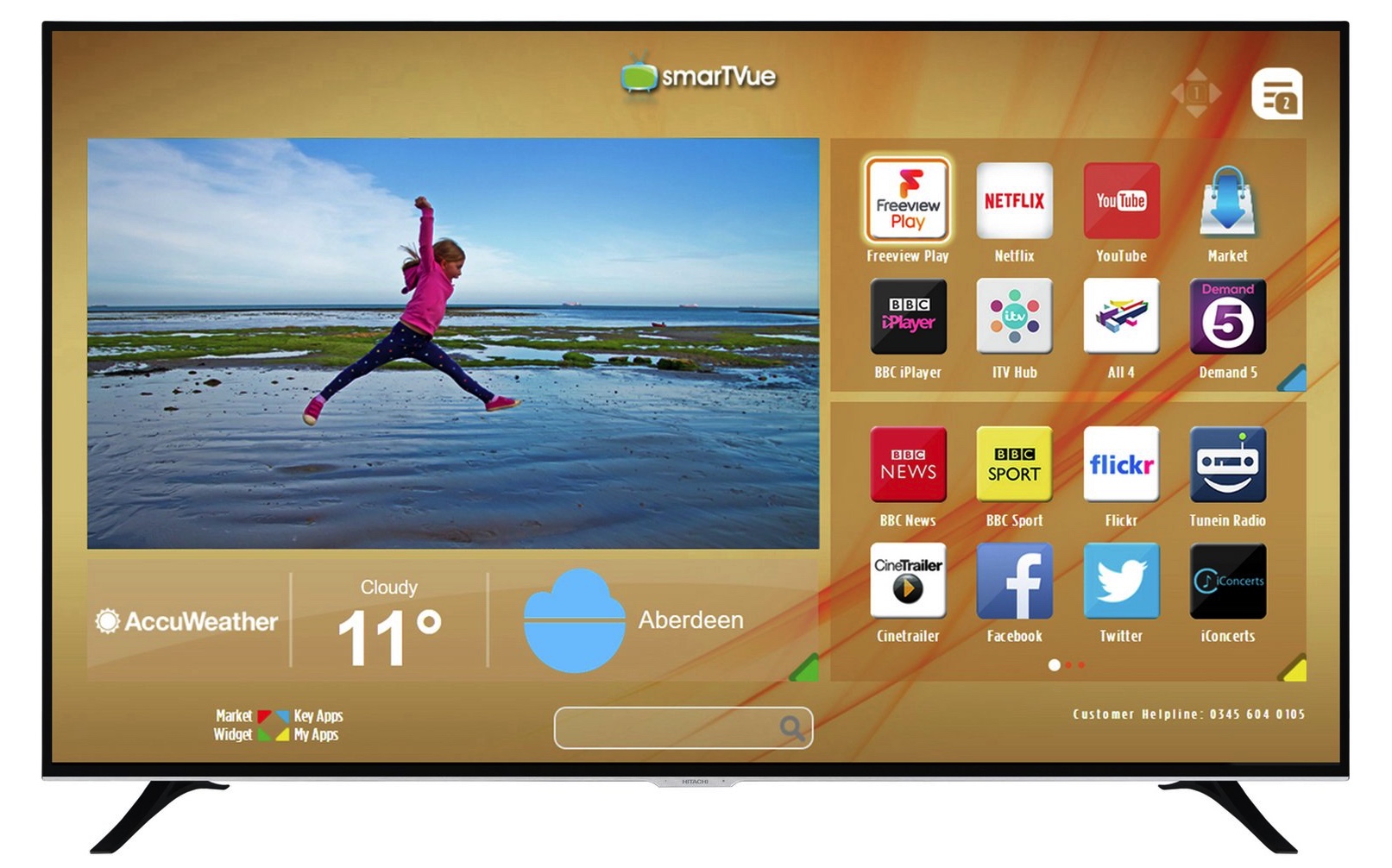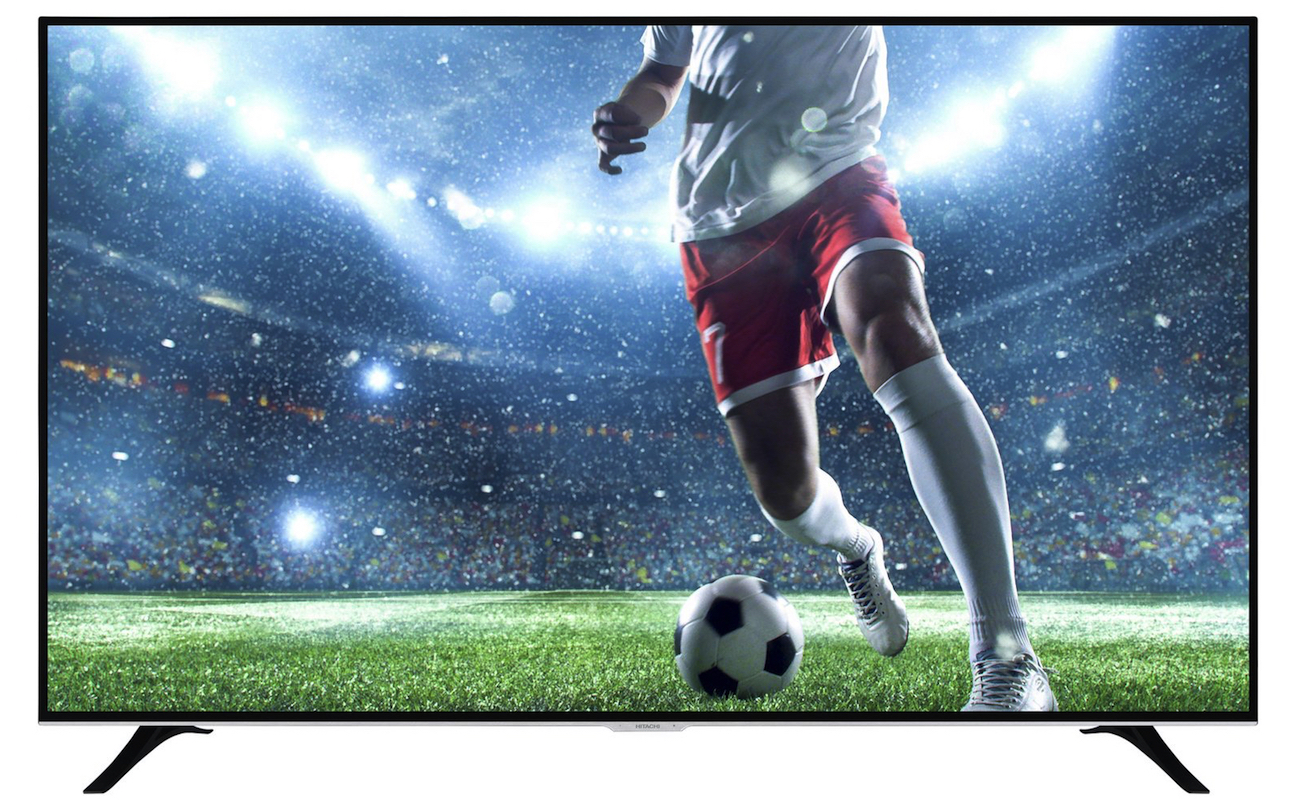Hitachi 75HL16T64U
The first thing to say is that Hitachi isn’t strictly speaking Hitachi anymore. For while it’s possible Hitachi engineers have had some sort of say in the 75HL16T64U, it’s clear from its onscreen menus and remote control that it’s really emerged from the factories of Turkish manufacturer Vestel.
That, in many ways, acts as a preface for this review: When it comes to TVs, deals that seem too good to be true usually are.
Design
The 75HL16T64U is not a particularly handsome TV - which is a bit unfortunate considering how much of your living room it consumes. Its frame is wider than those wrapped around most modern TVs, and its rear sticks out further.
The frame feels pretty plasticky too - though to be fair, it does try to hide this behind a reasonably attractive faux-metallic finish.
Hitachi/Vestel has thoughtfully made it easier to shift the 75HL16T64U around by fitting its rear with four carry handles. Though happily these can be removed if you’re trying to trim the set down for wall hanging.
Connections are respectable for such a cheap TV. Three HDMIs get the ball rolling, and these are joined by a pair of USB ports for multimedia playback, a VGA-type PC port, and a golden oldie in the shape of a composite video input. Plus, of course, there’s onboard Wi-Fi for taking the TV online.
Note that only two of the HDMIs can handle 4K HDR, and that even those two can’t handle HDR as well as 4K if the content is running at more than 30 frames a second.
Design TL;DR: The 75HL16T64U is chunkier than most modern TVs, which doesn’t exactly help its vast screen blend into your decor. The pseudo metallic finish is decent, though.

Smart TV (Proprietary OS with Freeview Play)
Given how cheap it is, it wouldn’t have been at all surprising if the 75HL16T64U had no smart features at all. So it’s pretty pleasing to find it carrying a small selection of built-in apps that include the catch-up TV platforms for the UK’s ‘big four’ terrestrial broadcasters, as well as YouTube and Netflix.
The broadcaster catch up apps are even provided as part of the Freeview Play platform, meaning you can access their wares via a simple, backward-scrolling electronic programme guide. The Netflix app supports the platform’s 4K, HDR streams, too - though YouTube is seemingly locked to HD and standard dynamic range.
The interface for accessing these smart features is pretty basic - but that also means it’s easy to use. That said, the biggest issue with the 75HL16T64U’s smart features is that there’s no Amazon Video app which means you'll ultimately need an additional streaming video player if you want to watch anything from Amazon's catalogue.
Smart TV TL;DR: The 75HL16T64U’s smart interface looks basic and runs a bit sluggishly, but it provides a more solid set of apps than might have been expected on the cheapest 75-inch TV we’ve ever seen.
HD/SDR Performance
The 75HL16T64U delivers a mixed bag of results with HD and standard dynamic range content. It actually does a pretty good job of presenting the most subtle colour nuances and balance of SDR, as well as delivering pretty consistently natural tones.
Or at least that’s the case with bright scenes. Black shades and dark colours are unfortunately affected by the 75HL16T64U’s uninspiring black level performance. Dark areas look grey, and dark colours look muted.
It doesn’t help, either, that even with the relatively low light requirements of SDR content, the edges of the picture show pronounced backlight clouding during dark scenes.
When it comes to upscaling HD to its screen’s native 4K resolution, the 75HL16T64U is best described as basic. Its upscaling processing just isn’t clever enough to spot the difference between ‘real’ picture information and source noise such as grain or digital compression artefacts. Which means that while upscaled pictures look pretty crisp and dense, they also tend to exaggerate noise.
HD/SDR Performance TL;DR: Bright SDR content looks surprisingly subtle and natural. Unfortunately, though, dark scenes are impacted by disappointing black levels and backlight clouding.
4K/HDR Performance
Here, too, we’re looking at a classic game of two halves with the 75HL16T64U.
In the bad half is the TV’s HDR performance. The Hitachi screen just doesn’t have anywhere near enough brightness or colour range to do deliver any sort of convincing HDR impact. In fact, HDR pictures appear with only slightly more brightness and colour intensity than SDR ones, robbing you of pretty much all of the extra punch and lifelike lustre that we expect HDR to deliver.
What’s more, the screen’s lack of brightness causes it to routinely ‘clip’ detail and subtle tone information out of the brightest parts of HDR pictures.
What little extra brightness the 75HL16T64U manages to find for HDR merely exaggerates the screen’s black level issues, too. Dark scenes look even greyer, and the clouding at the screen’s edges looks even more pronounced.
The bad news continues with the 75HL16T64U’s HDR colours. They look far less rich and punchy than they should - a problem exacerbated by a strange yellowy tone that lies across the top of the HDR image. So extreme is the extent to which the 75HL16T64U mutes colours with HDR content, in fact, that its SDR pictures look far more natural and engaging.
The 75HL16T64U does have one ace up its picture performance sleeve, though: killer sharpness with native 4K sources.

As well as rendering every pixel of UHD images with surprising accuracy, sharpness and noise-free clarity, the 75HL16T64U manages to retain much more of this clarity when there’s motion in the frame than I would have expected. There’s practically none of the blurring or judder you’d usually see with a budget TV.
The bottom line is that if the 4K source you’re watching is standard dynamic range rather than HDR, the 75HL16T64U really can serve up some startlingly good pictures - despite the fact that feeding it 4K sources don’t magically overcome its black level shortcomings.
It’s just a shame that the 75HL16T64U’s brightness and colour limitations make it only possible to (cautiously) recommend it to people who can feed it a regular diet of 4K pictures that aren’t accompanied by HDR. Which is actually harder to achieve than you might think.
4K/HDR Performance TL;DR: While the 75HL16T64U shows off the joys of a native 4K resolution, its HDR capabilities are essentially DOA.
Sound quality
The 75HL16T64U puts its chunky frame to good use with its audio performance: It can go room-fillingly loud without the speakers distorting or the cabinet rattling and presents impressive amounts of subtle movie mix detailing.
It spreads its sound a reasonable distance beyond the screen’s boundaries without anything starting to sound disconnected or ‘loose’.
And finally, its mid-range is expansive and dynamic enough to accommodate action scenes without the sound stage becoming thin or compressed.
Other panels to ponder
The 75HL16T64U is comfortably the most affordable 75-inch TV in town, making serious competition hard to find. The Samsung 75-inch MU7000 has much higher brightness and wider colour response makes it much more capable of unlocking the charms of HDR. But at £1,800 it costs £500 more than the 75HL16T64U.
If you can’t spend more than £1,300, you could consider the 65-inch UE65MU7000.
Verdict
Its combination of a 75-inch 4K, HDR-capable screen with a £1,300 price tag makes the Hitachi 75HL16T64U a mouthwatering prospect for cash-strapped home cinema fans. And actually, if you can feed it as much standard dynamic range 4K content as possible, it can give you better pictures than you’ve any right to expect.
That said, contrast is never better than average. And as soon as you step outside the 4K SDR box things start to go pear-shaped fast. Especially, sadly, when it comes to HDR.
- Need a new 4K TV? Here are the best 4K TVs of 2018
0 comments:
Post a Comment